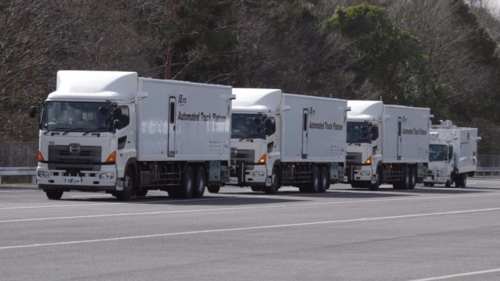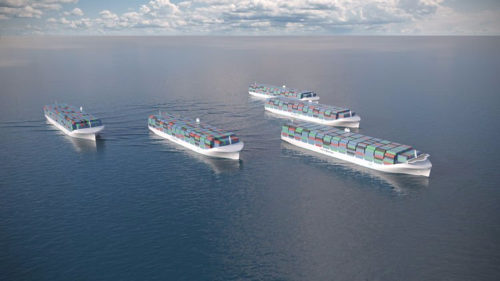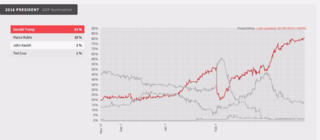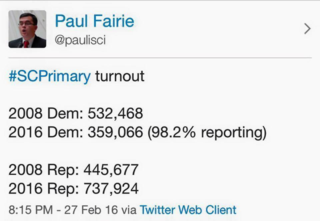John Robb's Blog, page 9
March 20, 2016
How the US ends up in a real Civil War this Fall
The US election could get worse. It could be a prelude to a civil war.
How so? Here's a simple scenario.
It's November 8th and the choice is between Trump and Hillary.
Both candidates have negatives approaching 70% (Hillary is currently at 56% and Trump is at 60%). The campaign has been vicious. A rematch of Hitler vs. Stalin in US politics.
For months, there has been violent protest in every US state. Protesters vs police vs. each other. Voters are edgy when they head to the booths on November 4th. Everyone is ready to put this campaign behind them.
However, things are about to change for the worse.
Early in the afternoon (EST) a small group of global guerrillas spring an N-1 trap (N-1 is a last moment action or betrayal) on the US:
A dozen faux bombs in suspicious packages are placed at heavily (Rep or Dem) polling locations resulting in evacuation and widespread concern.
Robocalls pour in to police departments and polling places in heavily (Rep or Dem) polling locations with bomb/terrorist threats. Widespread poll closures occur. Calls continue until late.
Election results are skewed. Electoral college swings to the candidate helped by the threats.
One candidate declares victory. The other cries foul. Protests go national. Violence, looting and active engagement with police.
Calls for calm ignored. Martial law is declared in different areas. Internet is turned off in different areas.
Violence grows. The global economy collapses due to uncertainty over US economy (ill conceived financial derivatives ensure that virulent US contagion spreads to every nook and cranny of the global financial and economic system).
The US, suddenly impoverished, extremely angry, and mortally betrayed stumbles into civil war.
Have fun,
John Robb
PS: The most interesting thing about this scenario is that it can be pulled off with only five people.
PPS: You can follow me on Twitter @johnrobb if you are interested in more of my thinking.
March 18, 2016
Why did Google dump Boston Dynamics?
Boston Dynamics pioneered walking robots, on both two legs and four (see video). BD's early demonstrated success led Google (aka Alphabet) to acquire them for their robotics mashup, Replicant, in December of 2013.
However, Google has changed their minds. Google is now putting Boston Dynamics up for sale.
The business press says that the reason for this sale "was a reluctance by Boston Dynamics executives to work with Google’s other robot engineers in California and Tokyo and the unit’s failure to come up with products that could be released in the near term." In other words, a culture clash.
My friend Monica Anderson, a pioneer in deep learning (and a Google alum), has a much better explanation. The team at Boston Dynamics wasn't able to make the transition to deep learning, the approach Google uses to produce limited AGI (artificial general intelligence).
Boston Dynamics (BD) are very successful pioneers. But their algorithms are not based on Deep Learning (DL) principles. And Google is leading the world in Deep Learning and can apply it to anything they want, including robotics. DL based algorithms do not provide a complete robotics solution today but there is wide agreement that this is the best path forward for the field. Why is this important? The difference is robots that can walk vs robots that can dance ballet. The goal is "graceful locomotion" which will be an order of magnitude more adaptive, more energy efficient, and faster than the current generation of robots.
I am suspecting this is part of the culture clash. Imagine a meeting where Google comes to BD staff and says "we want you to toss out all the software you have written, retrain your engineering staff to use DL and other Holistic methods, and create a new generation of robots capable of learning rather than being programmed"... then I can see BD staff saying "Ahem. That'll take a few years". And Google might then say "Forget that".
Changing one person's mindset and stance from Reductionist to Holistic methods is a multi-month to multi-year effort; I have tried that and have rarely succeeded. Now imagine a company's worth of engineers that need to do that switch. It might be much better, cheaper, and faster to start a company from scratch and hire a more receptive crowd of engineers. And seed them with Googlers that already drank the Holistic Kool-Aid.
The hardware solutions BD created is know-how and intellectual property that Google currently owns since they own BD. When they sell off BD they could exclude the key patents or sell them as non-exclusive licenses. Which means Google could start a competing robotics company, use the BD patents and hardware know-how, and add a Deep Learning based software stack to run that hardware much faster than they could turn Boston Dynamics around.
March 14, 2016
Instant Learning and the Next Economy
Let's face it. Human biological evolution is very slow. Our bodies and minds are roughly the same as they were ten thousand years ago.
That hasn't held us back though.
Thousands of years ago, we learned an unique way to transcend the limits of biological evolution. We learned that we can rapidly evolve as a group by gathering, storing, and sharing the experiences of individuals.
Technology has accelerated this process. It allows us to allocate an increasing percentage of our population to it (from scientists to teachers), more easily gather and store its torrents of information (computers and Moore's law), and share it instantly across the entire globe (the Internet and smartphones).
However, all of that earlier innovation is child's play compared to what is now possible. With limited AGI, it will be possible to exponentially accelerate the gathering, improvement, and sharing of human understanding. Here's how this is done in its most basic form (currently called cloud robotics):
An AGI learns a task or a concept through experience (this is becoming very easy to do with model free deep learning, Big Data and Big Sim as I pointed out yesterday).
That understanding is packaged, uploaded, and stored in the cloud.
Any other AGI can download that understanding as needed.
This is clearly a formula for radically accelerating the growth of human experience. A radical upgrade to the existing process.
Currently, when a human being learns something, it's accomplished through a slow and painstaking process. Worse, even when a human finally understands how something is done, it's hard to retain and even harder to share with others with any permanence. Yet, despite the imperfections of this system, we've made all the progress we see today.
Cloud robotics and limited AGI changes that. It makes it possible for human beings to capture understanding and store it in a way that makes it instantly available for anyone that needs it. This contrast in systems provides us with significant insight into what human beings enabled by limited AGI will be doing in the future. I believe the future of work will be:
Teaching AGIs everything we've already learned about the world. This is a herculean task and it has the potential to keep many of us busy doing it for many decades into the future.
Collaborating with AGIs to learn things we don't already know about the world. AGIs can learn how to do things without a formal knowledge of how something works. This is where engineers, scientists, and philosophers live and work.
Applying the understanding and capabilities of AGI to do things in the real world better and more easily than ever before. Most of us will be working in this space.
As you can see, there isn't a lack of opportunity for productive endeavor in the next economy. It's only limited by our imagination.
Have fun,
John Robb
PS: After AGIs learn through exposure to Big Data and Big Sim, they will need to refine that understanding through real world experience guided by human beings.
PPS: Since cloud robotics is a platform, the first movers that get it right win all (both countries and companies).
Humanity's Cloud gets an Upgrade
Cloud robotics, limited AGI, and the future of work
Let's face it. Human biological evolution is very slow. Our bodies and minds are roughly the same as they were ten thousand years ago.
That hasn't held us back though.
Thousands of years ago, we learned an unique way to transcend the limits of biological evolution. We learned that we can rapidly evolve as a group by gathering, storing, and sharing the experiences of individuals.
Technology has accelerated this process. It allows us to allocate an increasing percentage of our population to it (from scientists to teachers), more easily gather and store its torrents of information (computers and Moore's law), and share it instantly across the entire globe (the Internet and smartphones).
However, all of that earlier innovation is child's play compared to what is now possible. With limited AGI, it will be possible to exponentially accelerate the gathering, improvement, and sharing of human understanding. Here's how this is done in its most basic form (currently called cloud robotics):
An AGI learns a task or a concept through experience (this is becoming very easy to do with model free deep learning, Big Data and Big Sim as I pointed out yesterday).
That understanding is packaged, uploaded, and stored in the cloud.
Any other AGI can download that understanding as needed.
As you can see, in this basic form, this is a formula for radically accelerating the growth human experience.
It also provides us with significant insight into what human beings enabled by limited AGI will be doing in the future. The future of work will be:
Teaching AGIs everything we've already learned about the world. This is a herculean task and it has the potential to keep many of us busy doing it for many decades into the future.
Collaborating with AGIs to learn things we don't already know about the world. AGIs can learn how to do things without a formal knowledge of how something works. This is where engineers, scientists, and philosophers live and work.
Applying the understanding and capabilities of AGI to do things in the real world better and more easily than ever before. Most of us will be working in this space.
As you can see, there isn't a lack of opportunity for productive endeavor in the next economy. It's only limited by our imagination.
Have fun,
John Robb
PS: After AGIs learn through exposure to Big Data and Big Sim, they will need to refine that understanding through real world experience guided by human beings.
PPS: Since cloud robotics is a platform, the first movers that get it right win all (both countries and companies).
March 12, 2016
Game ON: the end of the old economic system is in sight

What makes this win interesting is that AlphaGo didn't win through brute force. Go is too complicated for that:
...the average 150-move game contains more possible board configurations — 10170 — than there are atoms in the Universe, so it can’t be solved by algorithms that search exhaustively for the best move.
It also didn't win by extensive preprogramming by talented engineers, like IBM's Deep Blue did to win at Chess.
Instead, AlphaGo won this victory by learning how to play the game from scratch using this process:
No assumptions. AlphaGo approached the game without any assumptions. This is called a model-free approach. This allows it to program itself from scratch, by building complex models human programmers can't understand/match.
Big Data. It then learned the game by interacting with a database filled with 30 million games previously played by human beings. The ability to bootstrap a model from data removes almost all of the need for engineering and programming talent currently needed for big systems. That's huge.
Big Sim (by the way, Big Sim will be as well known as Big Data in five years heard it here first). Finally, it applied and honed that learning by playing itself on 50 computers night and day until it became good enough to play a human grandmaster.
The surprise of this victory isn't that it occurred. Most expected it would, eventually...
Instead, the surprise is how fast it happened. How fast AlphaGo was able to bootstrap itself to a mastery of the game. It was fast. Unreasonably fast.
However, this victory goes way beyond the game of Go. It is important because AlphaGo uses a generic technique for learning. A technique that can be used to master a HUGE range of activities, quickly. Activities that people get paid for today.
This implies the following:
This technology is going to cut through the global economy like a hot knife through butter. It learns fast and largely on its own. It's widely applicable. It doesn't only master what it has seen, it can innovate. For example: some of the unheard of moves made by AlphaGo were considered "beautiful" by the Grandmaster it beat.
Limited AGI (deep learning in particular) will have the ability to do nearly any job currently being done by human beings -- from lawyers to judges, nurses to doctors, driving to construction -- potentially at a grandmaster's level of capability. This makes it a buzzsaw.
Very few people (and I mean very few) will be able to stay ahead of the limited AGI buzzsaw. It learns so quickly, the fate of people stranded in former factory towns gutted by "free trade" is likely to be the fate of the highest paid technorati. They simply don't have the capacity to learn fast enough or be creative enough to stay ahead of it.
Have fun,
John Robb
PS: Isn't it ironic (or not) that at the very moment in history when we demonstrate a limited AGI (potentially, a tsunami of technological change) the western industrial bureaucratic political system starts to implode due to an inability to deal with the globalization (economic, finance and communications) enabled by the last wave of technological change?
PPS: This has huge implications for warfare. I'll write more about those soon. Laying a foundation for understanding this change first.
March 11, 2016
Clip-on Robotics for Cars, Planes, and Ships
How does a global transportation system become a robotic transportation system almost overnight?
The answer is clip-on robots.
Robots (and their sensors) that you simply clip onto the driver's seat of the vehicle.
It sees what the driver/pilot/captain would see, both outside and in. It uses the same controls to control the vehicle. It hears the same things.
Simple. Effective. Inexpensive. Fast.
Here's an example of clip-on robot that can ride a motorcycle from Yamaha.
This approach gets around the need to rewire vehicle. Rewiring, as every engineer and mechanic knows makes things difficult. Simply, if you open up the control panel of a vehicle to modify it, the costs of installation go up exponentially and the regulatory burden (testing, certification, authorization) becomes insanely heavy.
It also gets around the problem with replacing existing vehicles with new, specially outfitted vehicles. That will only accelerate once the value of the new transportation system is demonstrated.
NOTE: This is very similar to how the big installed base of PCs were automagically converted "overnight" into Internet computers by simply adding a modem and some software...
This conversion will also be fairly inexpensive. All of the tasks associated with driving, flying and sailing can be accomplished using cameras and microphones. Although useful and increasingly affordable, complex sensors like LiDARs aren't required due to rapid advances in deep learning (Musk and Tesla are betting on this approach).
At the rate things are going, we'll see clip-on driving/flying/sailing systems in the mainstream within a decade Once that happens, the costs, benefits (1,000% safer than self-driving), etc. of these systems will make them ubiquitous soon thereafter.
Have fun,
John Robb
@johnrobb (twitter)
PS: Clip-ons are asymmetric. For example: Clip-ons could potentially turn any vehicle into a VBIED. They also allow a military that is behind to catch up fast with better funded institutions (think: how wireless phones allowed countries to leapfrog over wired infrastructure).
March 10, 2016
A Global Robotic Transportation System is Almost Here
Here's some thinking on the robotic transportation system that's headed our way. I believe it will arrive far faster than everyone suspects.
The shift to robotic transportation is already underway. Tens of thousands of cars are self-driving already and millions more are on the way. Millions of self-flying and self-navigating drones were sold this year alone. This revolution is even reaching the industrial level. The UK is testing convoys of driverless trucks on the M3 (and in the US, Nevada has already licensed a self-driving rig for highway use in Nevada) and
Rolls Royce is working on container ships that save the 40% of the cost of crewed ships.
All of these robotic vehicles are largely disconnected or they are using their own proprietary means of networking their activity. In order for robotic transportation to explode, it will need a simple protocol for coordinating this network in a decentralized way. That's already underway, although with very little of the importance I would allocate to it given the immensity of its potential impact. It appears to be on the right track though. Early indications are that this standard will be as simple and decentralized as TCP/IP (any extraneous detail on it, will slow its implementation and utility).
Once this scalable decentralized standard is developed, it will do for air, sea, land, and undersea transportation what the Internet did for the movement of data and in about the same amount of time. The change will be rapid as billions of robotic vehicles rapidly connect to this global grid providing things like (these are consumer examples, but you can extrapolate some military applications based on them):
Free car transportation. Order a self driving car on your cell phone, it's there in less than 5 minutes to pick you up. It will likely be free. How so? The value of selling services to the person in the vehicle is far greater than the cost of providing the service (electric self-driving fleet vehicle are very inexpensive).
Drone delivery. The local farmer delivers fresh eggs to you every day via drone delivery. Small package delivery via drones that pick up and deliver small packages. 5 miles in ten minutes for $0.25 a delivery. New industries explode by using this network as a platform.
Perpetual nomads. People live in their self-driving vehicle (RV with a twist). They travel at night while sleeping, jumping from place to place to get a charge, enjoy the locale, and get supplies.
Here's a short video to get a taste for how different a robotic transportation network would feel. Although this video is a bit over the top, it's safe to say that robotic transportation will be much faster, cheaper, and safer (1/10 the fatalities). For example, with robotic vehicles nobody would have to stop at a 10x10 intersection, they could just interleave at full speed.
Sincerely,
John Robb Twitter: @johnrobb
PS: Of course, all of this is for naught if the US isn't in the lead on setting this standard and quick to implement it nationally. If this doesn't happen. If the US lets the bureaucracies at the DMV and the FAA slow this effort down, the US will likely lose the entire robotic transportation industry to the place that does. Think about this; what would the US and the Internet look like today if the FCC had allowed the telcos to crush the early Web, and it started in China or the EU instead? How would this impact national defense? << this is something that Bob Work needs to focus on....
March 9, 2016
JOURNAL: Why the Technorati screws up
My friend Nassim Taleb (the well known philosopher of decision making) adds to our understanding of why the Technorati routinely make bad decisions (from the management of the economy to national security to social policy). It also explains why they screw up without taking responsibility for it.
What we are seeing worldwide, from India to the UK to the US, is the rebellion against the inner circle of no-skin-in-the-game policymaking "clerks" and journalists-insiders, that class of paternalistic semi-intellectual experts with some Ivy league, Oxford-Cambridge, or similar label-driven education who are telling the rest of us 1) what to do, 2) what to eat, 3) how to speak, 4) how to think... and 5) who to vote for.
With psychology papers replicating less than 40%, dietary advice reversing after 30y of fatphobia, macroeconomic analysis working worse than astrology, microeconomic papers wrong 40% of the time, the appointment of Bernanke who was less than clueless of the risks, and pharmaceutical trials replicating only 1/5th of the time, people are perfectly entitled to rely on their own ancestral instinct and listen to their grandmothers with a better track record than these policymaking goons.
Indeed one can see that these academico-bureaucrats wanting to run our lives aren't even rigorous, whether in medical statistics or policymaking. I have shown that most of what Cass-Sunstein-Richard Thaler types call "rational" or "irrational" comes from misunderstanding of probability theory.
March 7, 2016
The Hollow State Politics: The Left Behinds vs. Technorati
The shift from a marginally functional nation-state in manageable decline to a hollow state often comes suddenly..."Onward to a Hollow State"
The western-style democratic nation-state is in deep decline. As I've been warning for nearly a decade, the nation-state as we've known it is rapidly hollowing out. Simply, this century's spike in globalization, financialization, and technological change is gutting it and there's nothing that can be done about it. Further, this decline isn't a secret anymore. It's real and tangible and visible -- it's playing out in US politics right now.
Recently, we hit a new milestone in this decline. The forces hollowing us out have enabled the development of a unified ruling class. A class united by global outlook, education, financial success, status, and technological adoption.
This milestone became crystal clear after Super Tuesday, when everyone in the establishment, from the Democratic and Republican party regulars to the media elites to academic policy wonks to senior government employees to the heads of large corporations and financial firms, banded together to denounce Trump.
In that moment, connected as they were on social networks to confront their existential enemy, America's technorati was born.
The technorati, a group held together by social networking and unified by common values. A group that strongly senses it has more in common with the technorati of different countries than it does with the other people living in this country. A group that now understands their common interests are far more important than the petty political issues, party loyalties, and policy nuances that divide them.
Of course, the only problem facing the technorati is that it is a very small slice of the population. A small segment of the population that isn't growing. Globalization, financialization, and rapid technological change is not delivering the improvements it promised -- at least, not to anyone but the technorati. The rest of America is being left behind.
The left behinds are the supermajority of Americans getting creamed by the hollowing out of America.
Americans who lose more good good jobs, benefits, and status with each passing year. Americans who went deep into debt for college (in order to ascend to a slot in the technorati) but are perpetually underemployed. Americans who work all day but can only make enough to buy food with the money they earn. Americans now adrift in an America so culturally unmoored, it makes the “people of walmart” not only possible, but common.
The problem for the technorati is that the left behinds are starting to realize they've been conned.
They are starting to find their political voice, and their candidates want big changes. A demand that will only grow more intense as the hollowing out of America continues.
February 29, 2016
Trump's Insurgency (a must read)
Trump is trouncing the competition. He's doing so well that the prediction systems give him a 81% chance of winning the nomination -- despite the opposition of the entire Republican establishment.
What's most surprising to many pundits and analysts is that Trump has done this without presenting all of the detail plans, voluminous position papers, etc. that we've come to expect over the last couple of decades.
He has simply refused to play by those rules, and he's not paid a price for it.
Trump is able to pull this off because he's not running a political campaign. Instead, he's running an insurgency.
Not only that, it's a very specific type of insurgency. A type of insurgency so effective, it held the US at bay in Iraq for years, drove oil prices to $147 a barrel in 2007, and toppled governments in Egypt, Tunisia, Syria, and Libya.
This means he is playing by very different rules than his competitors. Let me walk you through an example of what I mean by that.
Candidates typically take positions on a range of issues. These issues serve as a means of attracting a coalition of voters energized by these issues. An open source insurgency works differently. It forms around a single idea. In Trump's insurgency, the central idea is seen in a tweet he made on the 29th of February:
It's a simple promise. It says: I'll Represent You and Your Needs as President
That's it. It might not seem revolutionary, but in a country where big money owns the political system, the middle class is being shredded, and politicians are afraid of offending anyone, this is a big deal.
With this promise in hand, Trump executed on the second important step in open source insurgency. He demonstrated that this promise was plausible. He's won again and again. Growing with each win.
This explains why:
Trump doesn't take policy positions on the small issues most campaigns are built on. Those positions would only divide his insurgency.
Trump will ONLY talk about corruption, hypocrisy, underhandedness etc. of the people opposing him.
Trump gains ground when he is attacked by the media, the corrupt, and special interests. These attacks demonstrate his devotion to the promise of his campaign.
Regardless of what you think about this, his insurgency is effective... note turnout in South Carolina in 2016.
This suggests that Trump's insurgency also has the capacity to take the White House this fall.
Have fun,
John Robb
PS: I'll post more about this later.
PPS: I've also worked out an unconventional strategy for Trump to win in the fall (against all comers). Not sure if I'll post that though. Haven't figured out one for Bernie though. It doesn't look like it will matter much since the Democratic machine is currently strangling him in the primaries.
John Robb's Blog
- John Robb's profile
- 17 followers










